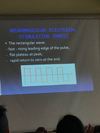Physics Test Tuesday March 20th Flashcards
Electrotherapy

the use of electric currents passed through the body to stimulate nerves and muscles, chiefly in the treatment of various forms of paralysis. (Google)
is a branch of the physical treatment, in which direct current and pulsed currents of low and medium frequencies are used for medicinal purposes. (slides)
Electrotherapy Tests
- (TENS) Transcutaneous electrical nerve stimulation
- (HVPC) High Voltage Pulsed Current
- Diadynamic Currents
- Interference Current
- (NMES) Neuromuscular Electrical Stimulation
- Electrical Stimulation of Denervated Muscle

(TENS) Transcutaneous electrical nerve stimulation
- Transcutaneous electrical nerve stimulation is the use of electric current produced by a device to stimulate the nerves for therapeutic purposes. (Google)
- The application of electrical stimulation to the skin via surface electrodes to stimulate nerve fibers primarily for pain relief. (slides)
Types of TENS
- conventional TENS
- acupuncture like TENS
- burst train TENS
- brief-intense TENS
Conventional TENS
(High Frequency, Low Intensity)
- most commonly used mode of electrostimulation
- combination of parameters stimulates A beta afferents

Convetional TENS Effects
- When A Beta fibers are stimulated, the conventional TENS mode achieves analgesia, primarily by spinal segmental mechanisms
-
Analgesia tends to be relatively short, lasting up to a few hours post-treatment
- Analgesia is the inability to feel pain.
-
Analgesia tends to be relatively short, lasting up to a few hours post-treatment
Conventional TENS Modes
- low intensity
- high frequency, over 100 Hz
- pulse duration is usually short, (50-80µs)

Acupuncture like TENS
(Low Frequency, High Intensity)
- Primarily stimulates A delta and C nociceptive fibers and small motor fibers
- Electrodes should be positioned to produce visible muscle contrations, over a myotome related to the painful area
Acupuncture Like TENS Modes
- Low frequency, (1-4 Hz)
- High Intensity, (enough to produce visible muscle contractions)
- long pulse duration, (200µs)

Acupuncture like TENS Effects
- patient will experience paraesthesia and muscle contrations with this mode
- the analgesia lasts longer than with conventional TENS
- <em>paraesthesia is an abnormal sensation, typically tingling or pricking (‘pins and needles’), caused chiefly by pressure on or damage to peripheral nerves.</em>
Burst Train TENS
(High Frequency trains of pulses delivered at Low Frequency)
- this is a mixture of conventional and acupuncture like TENS, and comprises a baseline low frequency current together with high frequency trains
- Patients must tolerate the stimulus intensity required to produce the desired strong muscle twitches, which are much better than single impulses
- <em>This type was developed by Eriksson and Sjolund in 1976 as a result of their experiences with chinese electroacupuncture</em>
Burst Train TENS Modes
- Low frequency of trains, (1-4 Hz)
- High Internal Frequency of Trains, (100 Hz)
- pulse duration, (100-200 µs)
Brief-Intense TENS
(High Frequency, Long Pulse Duration)
- this mode can be used for painful procedures such as skin debridement, suture removal, etc.
Brief-Intense TENS Modes
- High Frequency, (100-150 Hz)
- Long duration pulse, (150-250 µs)
(Not important)
Postions of Electrode Placement

TENS Indications
TENS is useful for:
TENS is useful for:
- Pain relief after amputation
- Nerve pain after shingles
- phantom pain
- peripheral neuropathies caused by metabolic disorders
- pain-related cause of CNS damage
(HVPC) High Voltage Pulsed Current
Parameters
- very short phase durations, (5-6 µs)
- very high peak, current amplitude (2000-2500 mA)
- a high-driving voltage, (up to 500V)
- The total current delivered to tissue does not exceed (1.2-1.5 mA)














